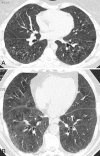Non-specific interstitial pneumonia in cigarette smokers: a CT study
- PMID: 19214521
- PMCID: PMC2691530
- DOI: 10.1007/s00330-009-1308-7
Non-specific interstitial pneumonia in cigarette smokers: a CT study
Abstract
The goal of this study was to seek indirect evidence that smoking is an aetiological factor in some patients with non-specific interstitial pneumonia (NSIP). Ten current and eight ex-smokers with NSIP were compared to controls including 137 current smokers with no known interstitial lung disease and 11 non-smokers with NSIP. Prevalence and extent of emphysema in 18 smokers with NSIP were compared with subjects meeting GOLD criteria for chronic obstructive pulmonary disease (COPD; group A; n = 34) and healthy smokers (normal FEV(1); group B; n = 103), respectively. Emphysema was present in 14/18 (77.8%) smokers with NSIP. Emphysema did not differ in prevalence between NSIP patients and group A controls (25/34, 73.5%), but was strikingly more prevalent in NSIP patients than in group B controls (18/103, 17.5%, P < 0.0005). On multiple logistic regression, the likelihood of emphysema increased when NSIP was present (OR = 18.8; 95% CI = 5.3-66.3; P < 0.0005) and with increasing age (OR = 1.04; 95% CI = 0.99-1.11; P = 0.08). Emphysema is as prevalent in smokers with NSIP as in smokers with COPD, and is strikingly more prevalent in these two groups than in healthy smoking controls. The association between NSIP and emphysema provides indirect support for a smoking pathogenesis hypothesis in some NSIP patients.
Figures



References
-
- {'text': '', 'ref_index': 1, 'ids': [{'type': 'PMC', 'value': 'PMC1745385', 'is_inner': False, 'url': 'https://pmc.ncbi.nlm.nih.gov/articles/PMC1745385/'}, {'type': 'PubMed', 'value': '10525560', 'is_inner': True, 'url': 'https://pubmed.ncbi.nlm.nih.gov/10525560/'}]}
- Moon J, du Bois R, Colby TV, Hansell DM, Nicholson AG (1999) Clinical significance of respiratory bronchiolitis on open lung biopsy and its relationship to smoking related interstitial lung disease. Thorax 54:1009–1014 - PMC - PubMed
-
- {'text': '', 'ref_index': 1, 'ids': [{'type': 'PubMed', 'value': '10584810', 'is_inner': True, 'url': 'https://pubmed.ncbi.nlm.nih.gov/10584810/'}]}
- Heyneman LE, Ward S, Lynch DA, Remy-Jardin M, Johkoh T, Müller NL (1999) Respiratory bronchiolitis, respiratory bronchiolitis-associated interstitial lung disease, and desquamative interstitial pneumonia: different entities or part of the spectrum of the same disease process? Am J Roentgenol 173:1617–1622 - PubMed
-
- {'text': '', 'ref_index': 1, 'ids': [{'type': 'DOI', 'value': '10.1513/pats.200512-131TK', 'is_inner': False, 'url': 'https://doi.org/10.1513/pats.200512-131tk'}, {'type': 'PubMed', 'value': '16738192', 'is_inner': True, 'url': 'https://pubmed.ncbi.nlm.nih.gov/16738192/'}]}
- Taskar VS, Coultas DB (2006) Is idiopathic pulmonary fibrosis an environmental disease? Proc Am Thorac Soc 3:293–298 - PubMed
-
- {'text': '', 'ref_index': 1, 'ids': [{'type': 'DOI', 'value': '10.1183/09031936.05.00021005', 'is_inner': False, 'url': 'https://doi.org/10.1183/09031936.05.00021005'}, {'type': 'PubMed', 'value': '16204587', 'is_inner': True, 'url': 'https://pubmed.ncbi.nlm.nih.gov/16204587/'}]}
- Cottin V, Nunes H, Brillet PY, Delaval P, Devouassoux G, Tillie-Leblond I, Israel-Biet D, Court-Fortune I, Valeyre D, Cordier JF, Groupe d’Etude et de Recherche sur les Maladies Orphelines Pulmonaires (GERM O P) (2005) Combined pulmonary fibrosis and emphysema: a distinct underrecognised entity. Eur Respir J 26:586–593 - PubMed
-
- {'text': '', 'ref_index': 1, 'ids': [{'type': 'DOI', 'value': '10.1111/j.1365-2559.2004.01921.x', 'is_inner': False, 'url': 'https://doi.org/10.1111/j.1365-2559.2004.01921.x'}, {'type': 'PubMed', 'value': '15330806', 'is_inner': True, 'url': 'https://pubmed.ncbi.nlm.nih.gov/15330806/'}]}
- Craig PJ, Wells AU, Doffman S et al (2004) Desquamative interstitial pneumonia, respiratory bronchiolitis and their relationship to smoking. Histopathology 45:275–282 - PubMed

